Wolverhampton District Electric Tramways
History
The story of the Wolverhampton District Electric Tramways has its genesis in 1896, with the British Electric Traction Company Limited's development of ambitious plans for a large electric tramway network centred on the Black Country and Birmingham. In order to bring these to fruition, in late 1896 and early 1897, the BETCo began negotiations with the various local authorities and existing tramway companies in the area, in order to gain their support and also, deferment of the dates on which the authorities' would have had the right to buy the existing tramways within their respective municipal boundaries.
Later that year, the BETCo promoted its Wolverhampton and District Tramways bill, which would have given it powers to acquire and convert the various horse and steam tramways belonging to the Wolverhampton Tramways Company, the Dudley and Wolverhampton Tramways Company, and the South Staffordshire Tramways Company. Unfortunately, it was unable to overcome the plethora of objections and demands raised by Wolverhampton Corporation, so it had to withdraw the bill. It subsequently made two further attempts to appease the corporation (in May 1897 and January 1898), and finally reached agreement on all bar one point — the high price demanded by the corporation for municipally generated electricity — which ultimately proved to be a step too far for the company.
Despite these setbacks, the BETCo was undeterred, and it eventually reached agreement with the other local authorities, as well as with the existing horse and steam tramway companies in the area, almost all of which it had gained control of by 1898. The tracks and assets of the Dudley and Wolverhampton Tramways Company, a standard-gauge steam tramway were acquired on the 22nd April 1899, together with pending powers to convert the line to 3ft 6ins-gauge and electric traction, the latter being granted on the 9th August 1899 (under the Dudley and Wolverhampton Tramways Order, 1899). Likewise, the tracks and assets of the Wolverhampton Tramways Company (outside the Wolverhampton municipal boundary) were acquired on the 1st May 1900, together with existing powers to convert them to 3ft 6ins-gauge and electric traction (under the Wolverhampton Tramways Order, 1899).
Meanwhile, Wolverhampton Corporation had acquired powers of its own to construct an electric tramway system (in August 1899), and had then proceeded to acquire the tracks of the Wolverhampton Tramways Company (and the former D&WTCo) within the municipal boundary. Furthermore, and not for want of trying on the part of the BETCo, it was made abundantly clear to the company that the corporation would under no circumstances countenance the company operating trams within its boundary. The corporation's attitude effectively left the BETCo to build an electric tramway network that lay wholly outside Wolverhampton, but which would meet the corporation's tracks at three points.
Further powers, to build a series of new electric lines centred on Bilston, were granted to the BETCo under the South Staffordshire Light Railway Order, 1900 (on the 11th August), and the South Staffordshire Light Railway (Extensions) Order, 1900 (on the 1st September 1900), following which, on the 17th December 1900, it set up a new subsidiary — Wolverhampton District Electric Tramways Limited — to take over the lines that had just been converted, as well as others that it planned to convert or build.
The first electric section to open, on the 3rd October 1900, was between Dudley and Sedgley (the old D&WTCo steam tramway), which the BETCo did not operate itself, instead, leasing it to another of its local electric tramway subsidiaries, the Dudley, Stourbridge and District Electric Traction Company. The converted tramway included a new section at its southern end (i.e., in Dudley), which connected it to the tracks of the DS&DETCo; these would eventually allow through running to Dudley Station. The connecting line was known as the Stafford Street Light Railway, and was built under the Dudley and District Light Railways (Extensions) Order, 1900 (approved on the 3rd April 1900).
The lines of the former WTCo, as well as the powers to convert them, were transferred to the WDETL on the 1st February 1901. The next section of electric tramway to open was the remaining section of the old steam line from Sedgley to Fighting Cocks — on the 9th January 1902 — which the DSDETCo continued to operate for a short while, before the WDETL eventually took over, either later that month or in early February 1902. The rest of the WDETL's new electric system was brought into use later that year: Fighting Cocks to Bilston, Moxley to Bilston, and Stow Heath Lane to Bilston on the 14th July 1902; Willenhall to Bilston on the 15th July 1902; Moxley to Bradley, and Willenhall to Dean's Road on the 4th November 1902; and Darlaston to Willenhall on the 6th December 1902. The latter effectively took the WDETL's system to its final size of 14.67 miles, though it was to operate considerably more mileage than this for a short time during the 1920s, when it took over some of the services of its sister company, the South Staffordshire Tramways (Lessee) Company (see later).
The tracks of the WDETL met those of the SST(L)Co at Moxley, which allowed the latter's tramcars to work through to Bilston, and the former's to Darlaston.
The relationship between the company and Wolverhampton Corporation was, however, still far from cordial, a situation that was no doubt exacerbated by the latter's selection of the unproven Lorain surface-contact system for its new tramway, and its public insistence that it would under no circumstances allow the erection of overhead wiring within the municipality. On the corporation's Bilston line, where the municipal boundary ran along the centre of the road for around half-a-mile — between Ettingshall Lane and Stow Heath Lane — the corporation built its new Lorain tracks (opened on the 24th September 1902) on its side of the boundary, the tracks meeting those of the WDETL at Stow Heath Lane. The relationship between the two parties seems, however, to have thawed somewhat by the 24th January 1903, when the company agreed that the corporation's horsecars on the Willenhall line could run through to Dean's Road, the boundary here once again running along the centre of the road — between Coventry Street and Dean's Road — each party owning one rail.
On the 27th October 1903, the BETCo formally transferred ownership of all the remaining tramways in the area, as well as the orders under which they had been built, to the WDETL.
On the 4th December 1903, it was agreed that all the BETCo's Black Country and Birmingham-area tramway interests would be merged into Birmingham & Midland Tramways Limited. From the 1st July 1904, all these systems (operated by Birmingham and Midland Tramways Limited; the City of Birmingham Tramways Company; the Dudley, Stourbridge and District Electric Traction Company; the South Staffordshire Tramways [Lessee] Company; and Wolverhampton District Electric Tramways Limited) were managed as a single entity by the Birmingham and Midland Tramways Joint Committee (B&MTJC). The merger resulted in economies of scale across the enterprise, perhaps most notably in the introduction of a very successful Tramways Parcels Express Service (begun in 1905), and the setting up of a major tramcar building and maintenance facility at Tividale, between Dudley and Oldbury.
Meanwhile, Wolverhampton Corporation's new electric services to Fighting Cocks and to Dean's Rd were finally opened on the 8th March 1904 and the 23rd April 1904, respectively. Whilst the tracks of the WDETL and the corporation now met at three points on the municipal boundary (Fighting Cocks, Dean's Road, and Stow Heath Lane), and were connected at the latter two places, no through running took place, members of the public having to change from one operator's tramcars to the other's. The lack of through-running was a constant source of public criticism, so it was not long before the BETCo once again approached the corporation (in February 1905) to see whether they might come to some arrangement. Although the corporation was still implacably opposed to the installation of overhead wiring in the town, its position on company operation over its tracks had noticeably softened. As a result, agreement was reached for the corporation to equip some of its cars with overhead current collection equipment, and for the WDETL to equip some of its cars with Lorain surface-contact equipment. The agreement resulted in the corporation taking over all services to Bilston and Willenhall (from the 9th November 1905, and the 18th April 1906, respectively), with WDETL cars running right through from Dudley to Wolverhampton (from the 15th October 1906). The latter services, however, only lasted until the 10th January 1909, as there was little increase in revenue on the line — in large part due to a severe trade depression — and the Lorain-equipped cars, which were over a ton heavier, proved to be expensive to operate and maintain.
The WDETL's parent company, the B&MTL was also heavily involved in electricity generation, as well as motorbus operation, the company having set up a new enterprise — Birmingham and Midland Motor Omnibus Company Limited, which became known as 'Midland Red' — to manage all the constituent companies' motorbus interests on the 1st July 1905. On the 13th August 1912, B&MTL changed its name to Birmingham District Power and Traction Company Limited, presumably to better reflect its interests, particularly its expansion into electricity generation and supply. The management committee (the B&MTJC) was restructured in August 1915, when it expanded to include additional BETCo interests (not owned by the BDP&TCo), amongst them the Kidderminster and District Electric Light and Traction Company, owners of Kidderminster and Stourport Electric Tramways. As a result, the name of the committee was changed to the Birmingham and Midland Joint Committee of Electricity, Tramways and Motor Omnibus Undertakings, though the less unwieldy original name (B&MTJC) continued in general use.
The Great War brought much disruption to the WDETL, including heavy loadings and greatly reduced maintenance, the latter due to loss of skilled workers (to the armed forces) and severe restrictions on spares and new materials. The tramway remained profitable, and despite rising costs and a post-war trade recession, the B&MTJC pressed ahead with major track renewal, new tramcars, and major rebuilds.
By the end of the Great War, Wolverhampton Corporation's Lorain surface-contact system was life-expired, but rather than renew it, the corporation instead elected to convert its system to overhead current collection, a set-up it had for many years been implacably opposed to, but which was much cheaper to install. As a consequence of the conversion, the WDETL was able to reintroduce through services on the Dudley line, these running right through to Wolverhampton Snow Hill from the 26th March 1921. Corporation services on the Bilston and Willenhall lines were able to run right through to their termini without stopping to change current-collection method from the 15th June 1921, and the 22nd June 1921, respectively.
That same year, the WDETL's parent company, the BDP&TCo, attempted to deal with the looming threat of lease expirations, many of its lines being leased from local authorities. Although it submitted a parliamentary bill, and entered into lengthy dialogue with the local authorities in an attempt to push the various expirations out to a single date of the 31st December 1938 (in return for significant investment), several of the larger authorities, particularly West Bromwich and Wolverhampton, which were committed to expansion of municipal operation, would not agree to any extension of the company's leases. As a consequence, the resulting bill — the Black Country Tramways and Light Railways Act, 1922 — was almost worthless as far as the company was concerned. The West Bromwich Corporation leases duly expired on the 30th March 1924, which spelled the end of tramway operation by the SST(L)Co, its remaining services being handed over to the DS&DETCo and the WDETL, the latter taking over operation of services between Bilston and Wednesbury, and the SST(L)Co's joint services with Walsall Corporation (between Wednesbury, Pleck and Walsall; and Darlaston, Pleck and Walsall).
Although the WDETL did not own any lines within Wolverhampton, the corporation had since its act of 1899, had the power to compulsorily purchase tramway lines outside the municipal boundary when the leases of the neighbouring authorities expired, providing that these lines were extensions of its own lines. The corporation had been successful in protecting these rights — within BDP&TCo's Black Country Tramways and Light Railways Act, 1922 — as well as harmonising dates at which the neighbouring authorities could purchase the tramways within their boundaries. Whilst these moves were aimed at expanding the municipal tramway system, by 1923, and despite having converted its tramway system to overhead current collection barely two years before, the corporation's thoughts had turned towards trolleybus operation, its first service — to Wednesfield — commencing on the 29th October 1923. It was not alone in its thinking either, Walsall also pursuing a similar course, and both eventually obtaining powers to acquire portions of the BDP&TCo's tramways, and to convert them to trolleybus operation. The latter corporation, by agreement with the company, took over operation of the WDETL's Willenhall Market Place to Crescent Road, and Willenhall Crescent Road to Darlaston services from the 1st October 1925, under a three-year lease, the former lines eventually bring sold to the corporation around June 1928.
These powers kick-started the gradual dismemberment of the WDETL's tramway network and its replacement by municipally operated trolleybus and/or motorbus services. The first line to succumb was Dudley to Fighting Cocks, which was taken over by Wolverhampton Corporation on the 15th August 1925, the last tram (Wolverhampton Corporation operated) running on the 6th November 1926. The corporation then took over the majority of the remaining lines as follows: Dean's Road to Willenhall (on the 9th August 1926, the last tram running the day before); Stow Heath Lane to Bilston (on the 27th August 1928, the last tram running the day before); Fighting Cocks to Bilston, Willenhall to Darlaston (via Bilston); and the branch to Bradley (on the 1st September 1928), the corporation continuing to operate the trams until 30th November 1928.
The WDETL's remaining services, which had been operated on behalf of the SST(L)Co — Darlaston to Walsall, and Wednesbury to Walsall (both operated jointly with Walsall Corporation), and Wednesbury to Darlaston — were handed over to the DS&DETCo on the same day as the Wolverhampton take-over, i.e., 1st September 1928. On the 1st November 1928, the DS&DETCo also took over operation of the Willenhall Crescent Road to Darlaston services following the expiry of Walsall Corporation's lease, the latter not wishing to convert the line to trolleybus operation.
Despite the wholesale tramway closures, the BDP&TCo's transport performance remained strong, in large part due to the Midland Red services, which were greatly expanded during the decade. On the 18th December 1929, the BDP&TCo once again changed its name, this time to the Birmingham and District Investment Trust limited.
The WDETL was formally wound up on the 15th September 1930.
The last Darlaston tram service, which was also the last service of all on the once large B&MTJC network, and which was probably operated by the SST(L)Co,was withdrawn on the 30th September 1930.
Uniforms
Over the course of its history, the BETCo either owned, part-owned or leased around fifty tramway concerns in the British Isles, across which it largely imposed a standard uniform policy. Although jackets varied somewhat between BETCo systems, as well as across the decades, the cap badges, collar designations and buttons invariably followed a standard pattern. However, in the case of the BETCo's Black Country and Birmingham systems (see link), the parent company appears to have initially allowed each of its subsidiaries a degree of autonomy, and this was certainly reflected in the uniforms worn. Photographs from this period invariably show WDET tramcar crews in greatcoats, which hide whatever uniform jackets were being worn underneath; fortunately, the odd photograph has survived without them, and these suggest that both motormen and conductors wore single-breasted jackets with a single pocket on the bearer's left breast, and stand-up collars; it is, however, currently unclear what insignia, if any, these jackets carried. Initially, headgear appears to have been informal (flat caps), but later on, drooping-peak caps were introduced; these bore the standard BETCo 'Magnet and Wheel' cap badge (see link), almost certainly in brass.
During these early years, i.e., prior to 1904/5, tramcar crews were issued with greatcoats with five pairs of buttons and high fold-over collars; the latter carried company initials, probably in individual brass letters — 'W D E T' — though the precise letters cannot be made out with certainty on surviving photographs. Conductors' greatcoats were single breasted, whereas motormen's appear to have been double breasted.
Following the creation of the B&MTJC on the 1st July 1904, a standard uniform policy was imposed across all the member companies, including the WDET. Motormen and conductors were now issued with double-breasted jackets with four pairs of buttons (bearing the standard BETCo 'Magnet and Wheel' device — see link) and high, fold-over collars; the latter carried individual metal initials — either 'B M T' or 'B & M T' — on the bearer's right-hand side and an employee number on the left-hand side, all almost certainly in brass. Surviving examples suggest that the first collar badges may have had diagonal striations, giving a rope-like effect (see below). The employee number was eventually dispensed with, leaving the left-hand collar badgeless.
The drooping-peak caps carried a tall, oval brass cap badge, which comprised intertwined 'BMT' initials beneath a 'Magnet and Wheel' device, all within a wreath (see below). At some point prior to the Great War, the caps were changed to a tensioned crown peaked style, though they continued to carry the same cap badge. B&MT jackets varied subtly in style across the decades, always double-breasted, but sometimes with four pairs of buttons and sometimes with five, and with three waist-level pockets. The jackets could be worn open at the neck giving the effect of lapels, or buttoned up; the collar insignia, however, remained unchanged right through to closure in 1930.
Although photographic evidence is currently lacking, inspectors most probably wore single-breasted jackets with hidden buttons (or more likely a hook and eye arrangement) and stand-up collars; the latter bearing 'Inspector' in embroidered script lettering. The standard ‘Magnet & Wheel’ cap badge (or 'B&MTJC' badge) was most probably worn, but with an embroidered, script-lettering 'Inspector' badge.
Female staff were employed during the Great War to replace men lost to the armed services; they were definitely employed as conductresses, though whether they were also employed as motorwomen remains unclear. These ladies were issued with tailored, single-breasted jackets with five buttons, lapels, and a belt with button fastening; it is currently unclear what insignia were worn on the lapels, though they may simply have been left plain. Headgear took the form of a dark-coloured straw bonnet or a baggy motor cap (probably for summer and winter wear, respectively); these bore the standard B&MT cap badge, attached to a ribbon in the case of the bonnet. Double-breasted, lancer-style greatcoats were also provided; these had five pairs of buttons, epaulettes and high, fold-over collars; the latter usually bore system initials on the right-hand collar only, but were also frequently left plain.
Further reading
For a detailed history of the WDET, see: Black Country Tramways Volumes 1 and 2, by J S Webb; (1974 and 1976).
Images
Motormen and conductors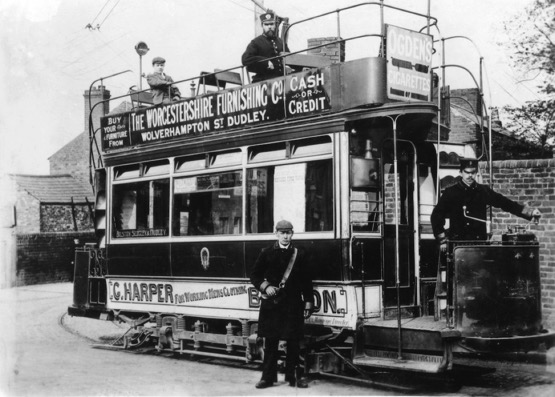
WDET Tramcar No 1 stands at Fighting Cocks in March 1903. Author's Collection.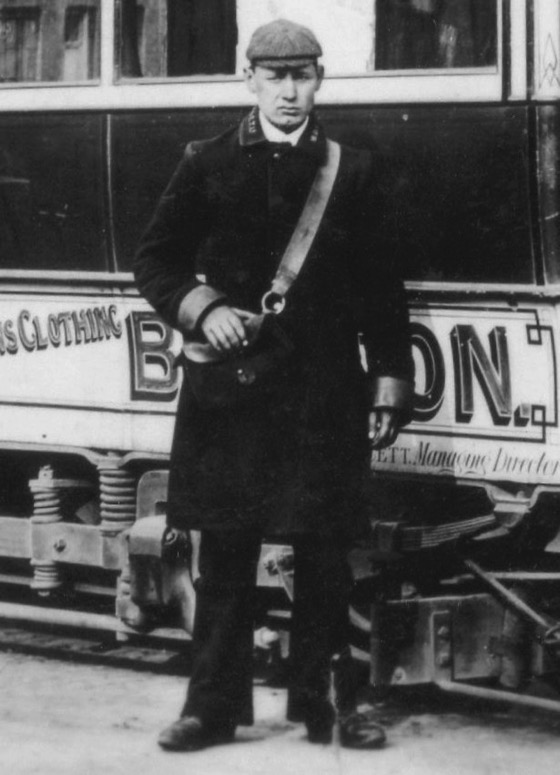
An enlargement of the above photograph showing the conductor, who is clearly wearing a company-issued greatcoat — with system initials on the collars — but with a flat cap.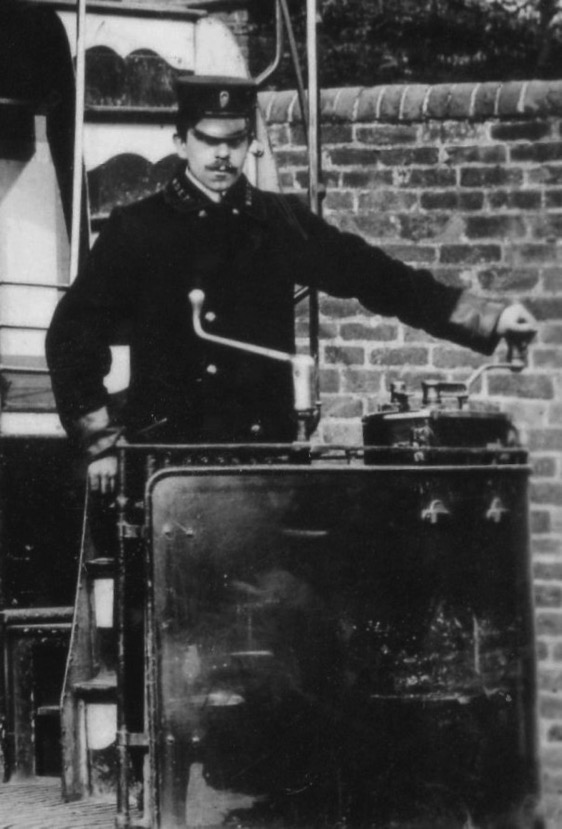
Another enlargement of the above photograph, this time showing the motorman, once again in company-issued greatcoat, but with a drooping-peak cap bearing the standard BETCo cap badge.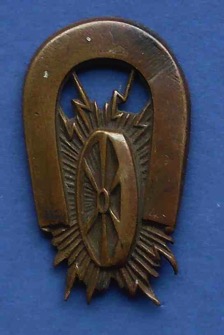
A Standard British Electric Traction Company ‘Magnet & Wheel’ cap badge — brass. This appears to have been worn between circa 1902 and 1904. Author's Collection.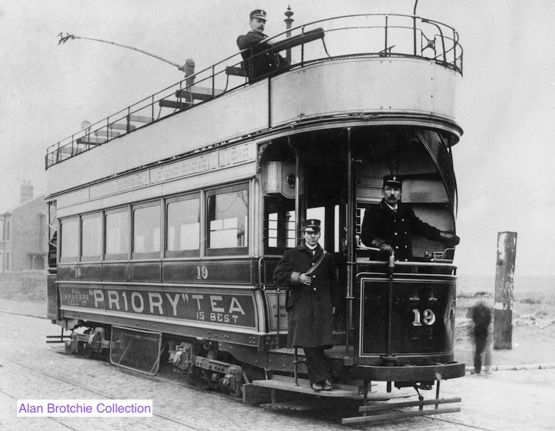
Tramcar No 19 (built by Brush in 1902) at the Stow Heath Lane terminus, which the WDET only operated until 1905 — photo undated, but given the pristine condition of the tram, probably taken in 1902 or 1903.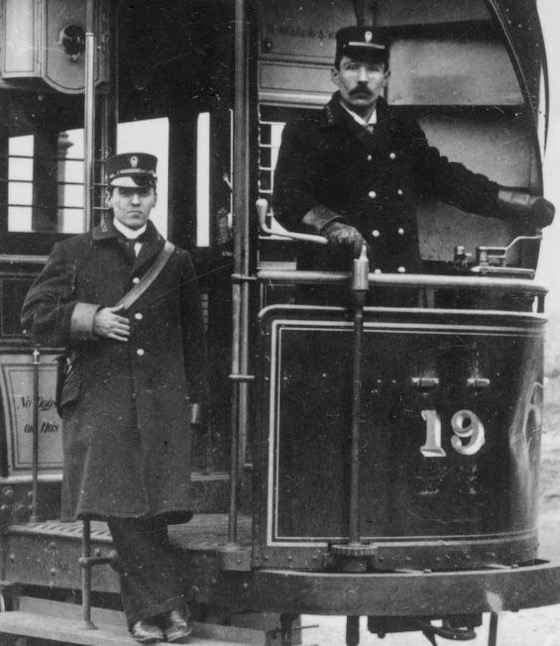
An enlargement of the above photograph revealing both men to be wearing greatcoats and drooping-peak caps, the latter bearing the standard BETCo 'Magnet & Wheel' cap badge. The fact that both men's collars and ties are to be seen suggests that they are wearing jackets with lapels underneath their overcoats, either that or no jackets at all. The right-hand collars bear system initials.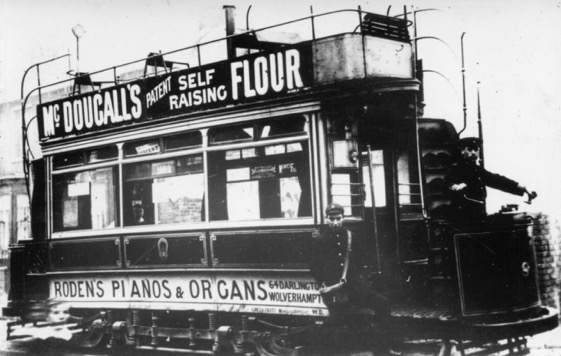
Another photograph that appears to have been taken at Fighting Cocks, again of a No 1-13 series tramcar, but with a later style of lifeguard and a headlamp fitted on the dash, so possibly taken in 1904/5. Photo courtesy of the Tramways and Light Railway Society, with thanks to David Voice.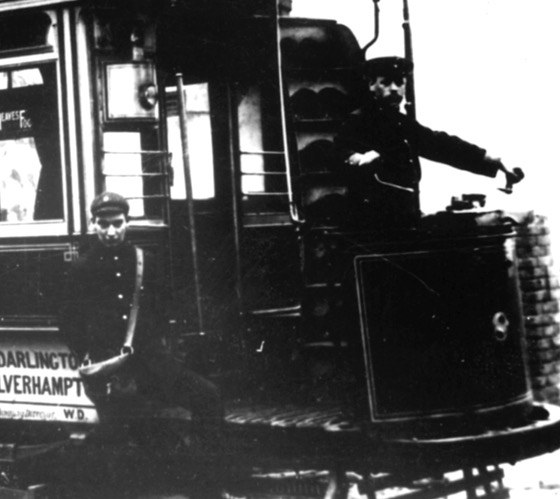
An enlargement of the above photograph, which though of very poor quality, does show that the tramcar crew are both wearing single-breasted jackets. Whilst the conductor is wearing a flat cap (with BETCo cap badge), his colleague would appear to have a tensioned-crown cap.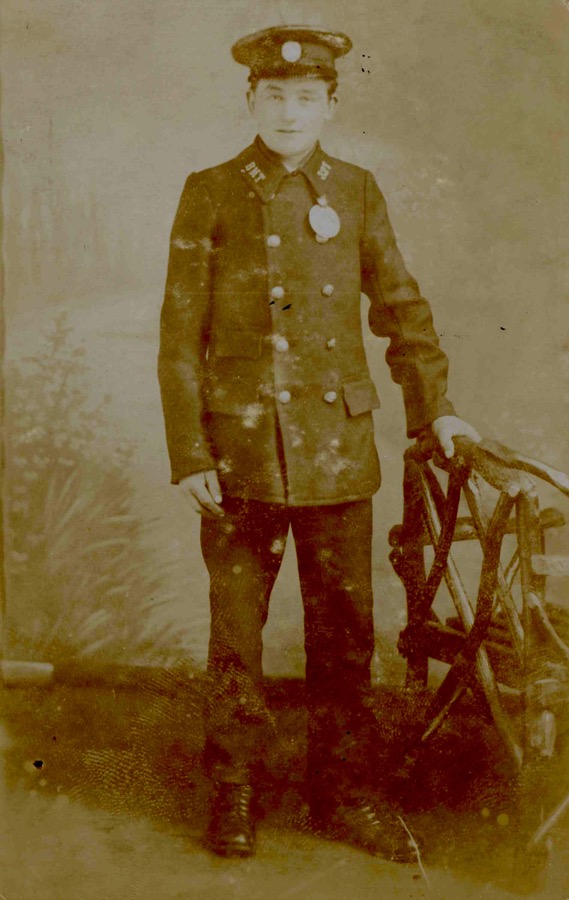
'BMTJC' tramwayman No 321 in double-breasted tunic with later style of tensioned-crown peaked — photo undated, but very probably taken during or shortly after the late-Edwardian era. There is unfortunately nothing to identify which of the B&MJTC's constituent tramway companies the above individual worked for. However, as uniforms were standardised, it is fairly safe to say that the photograph is representative of the uniform worn by staff of the WDET, though the presence of a licence indicates that the subject worked within the Birmingham municipal boundary (i.e., for either the B&MTL, the CofBTCo, or the SST(L)Co.
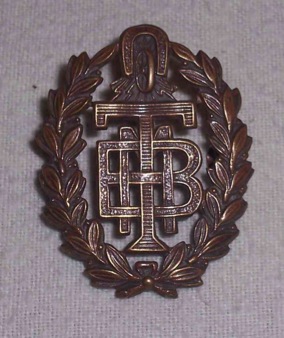
B&MTJC cap badge — brass. This was introduced some time after 1904, when Wolverhampton District Electric Tramways was managed by the B&MTJC. The badge incorporates the British Electric Traction Company's 'Magnet and Wheel' device; the BETCo of course controlled the B&MTJC and all its constituent tramway companies. Author's Collection.
Probable B&MTJC early 'rope effect' collar initials and collar number; these were eventually superseded by plain brass letters/numbers. Author's Collection.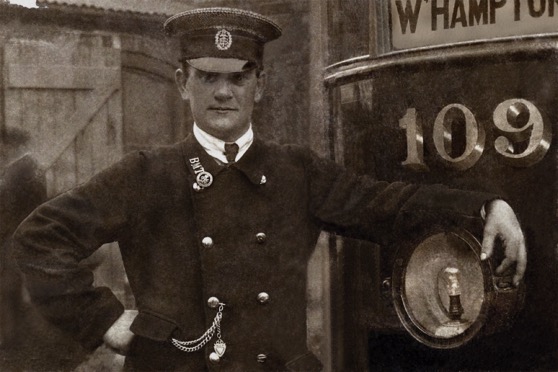
A WDET motorman stands with what is, in all probability, a brand-new, B&MTJC-built Tramcar No 109, dating the photo to 1919/1920. Photo courtesy of John Dawson.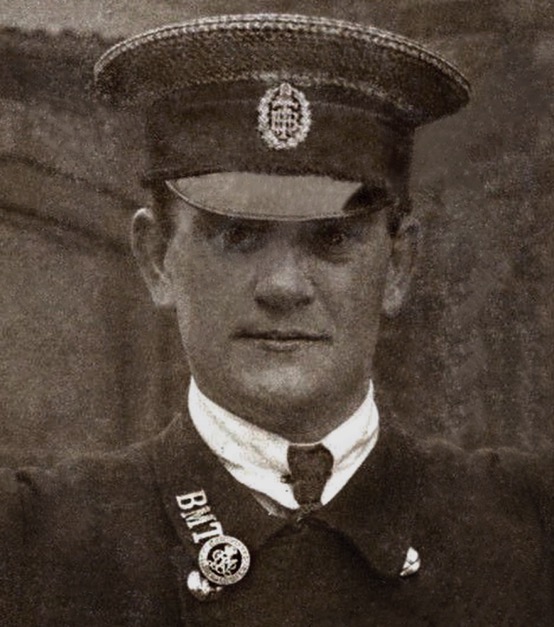
An enlargement of the above photograph showing details of the cap badge and collar insignia. A date of 1919/1920 is further reinforced by the Silver War Badge on the subject's right-hand collar, indicating that he had been honourably discharged from the armed services during the Great War.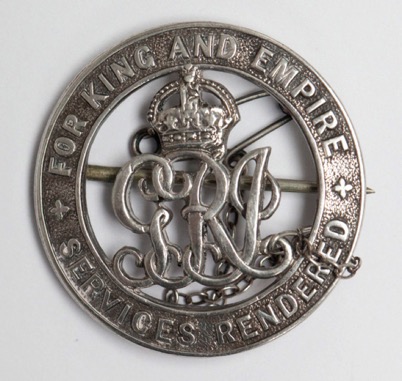
Silver War Badge 1916. Photo courtesy of John Dawson.
Female staff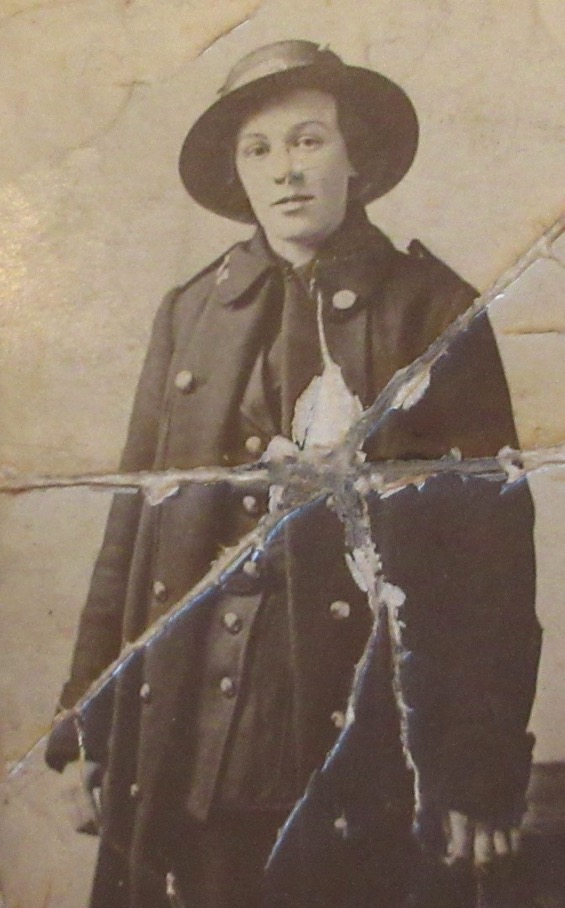
A very rare photo of a WDET Great War tram conductress, Ethel Jones (later Burrows). Miss Jones joined the tramway in 1915 aged 17 years (giving her age as 19), and served for four years, primarily working between Dudley, Fighting Cocks and Bilston. She subsequently returned to conducting in the Second World War, working on the buses for Wolverhampton Corporation Transport. She is wearing what would appear to be a double-breasted, lancer-style greatcoat, with epaulettes and high fold over collars; her right-hand collar bears individual system initials, 'B M T'. The tunic underneath is mostly hidden, but is clearly single-breasted with lapels, five buttons and a waist belt (with button fastening). Her headgear is a black straw bonnet, which though it is not evident here, almost certainly bore the standard BMT cap badge. Photo by kind permission of Ethel's daughter, Margaret Hassall.